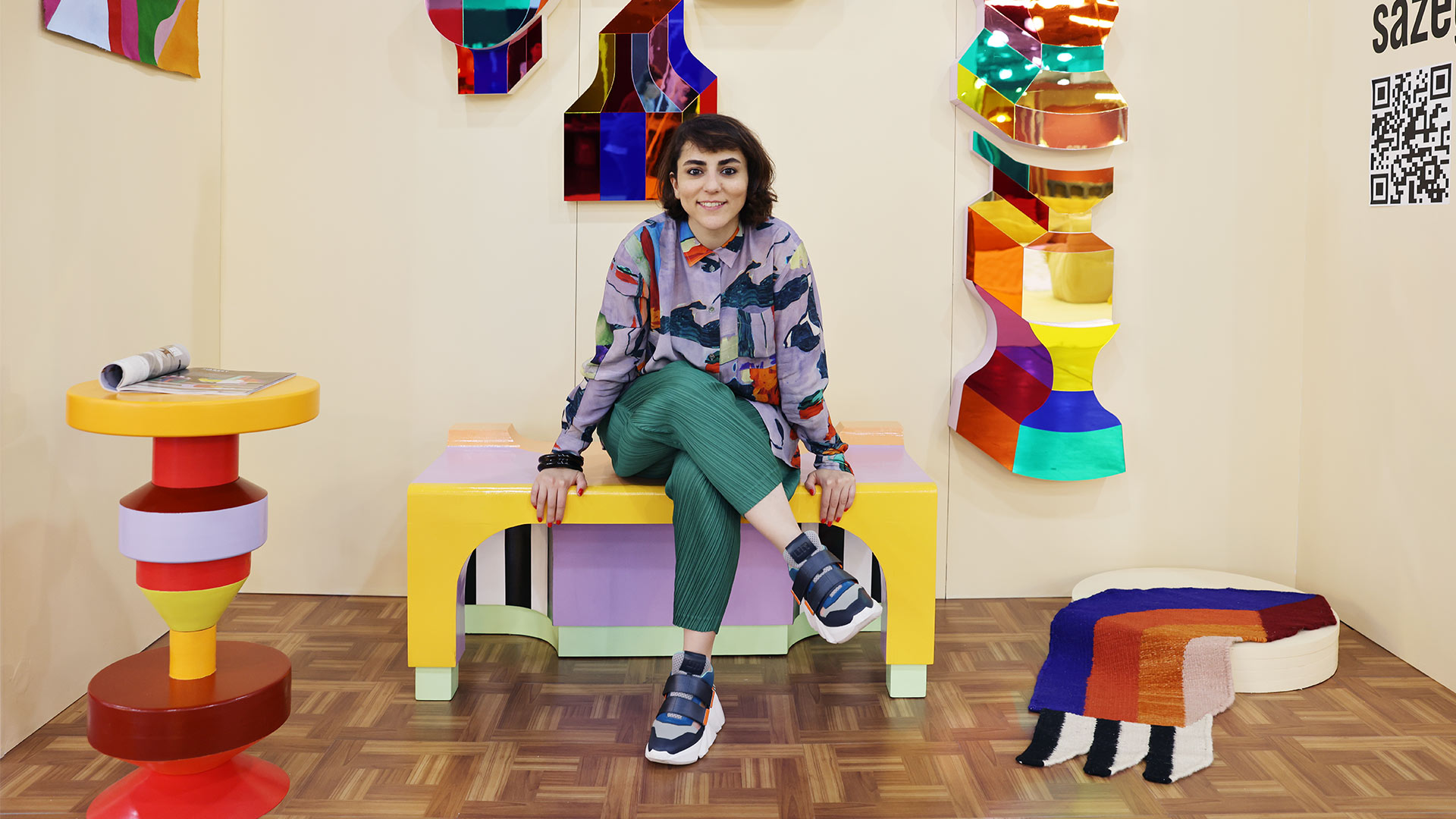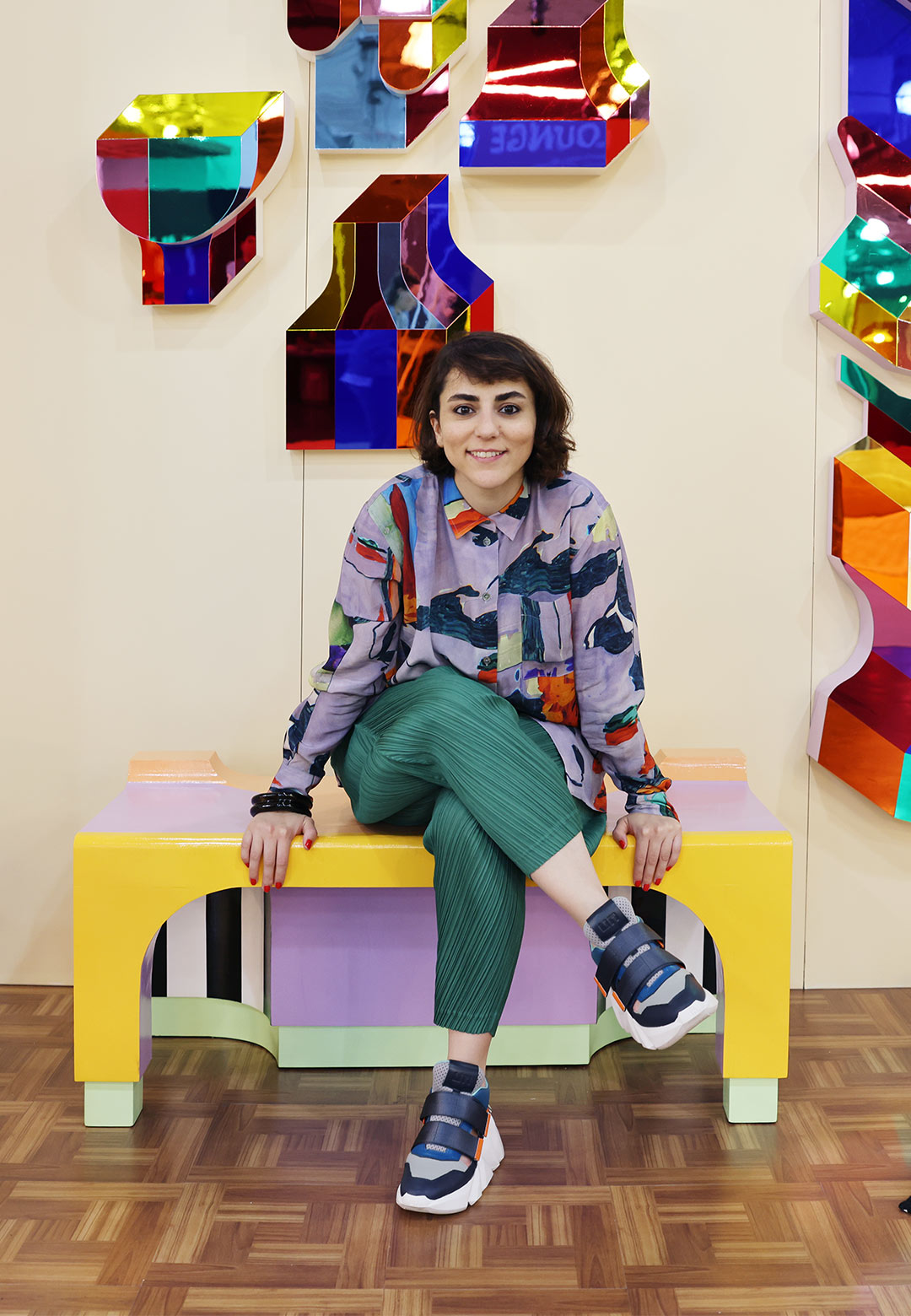New York-based Mana Sazegara is an architect, graphic designer and furniture designer whose practice focuses on the development of both two-dimensional and three-dimensional entities, doused with cogent personas worth interacting with. “My work comes to life through negotiations between shapes, forms, layers, colours, and textures. I situate my practice at the intersection of architecture and graphic design: engaging, enhancing and empowering life,” she shares. Sazegara veritably maintains her accreditation as an interdisciplinary designer, undertaking experiments to build a range of different objects such as mirrors, chairs, benches, stools, rugs, totems, lamps, posters and illustrations, as well as visual and graphic identities. Having received a formal education in architecture from the Shahid Beheshti University in Tehran, Iran, and the School of Design, University of Pennsylvania, Philadelphia in Pennsylvania, USA, Sazegara has also briefly worked on architectural projects.
Sazegara hails from Tehran in Iran and currently resides in New York. Her practice, having developed gradually over the past decade, leans towards the creation of products and graphics that focus on expression over functionality. Her creations are designed to stand out with their bold and vibrant colour palettes, and anomalously construed compositions. Her designs, inspired by architectural forms, bear semblance to the clashing hues and abstract geometries of the Memphis style.
Sazegara’s pieces feature characters formatted to function as utilitarian objects. Each design is a reinterpretation of common architectural monoliths and motifs, abstracted to simplified formats, and in turn, invites the viewer to expand their imaginations. “Urbanity and social life is the centric idea behind the designs I create. Individuals in an urban setting are different in essence and yet, keep each other company, being flexible to one another and sharing many essential characteristics. Filled with stories in their heart, the objects are made out of geometric modules which are scalable, and can be transformed into different pieces of furniture,” the product designer explains.
Below, STIR shares a glimpse of the Iranian designer’s humorous experiments in product designs.
Mirrors on the wall: Charlie, Alice, Olive and MM1
While 'Alice,' a mirror made out of simple shapes, is composed in a manner such that each individual component appears extruded, 'Charlie' is a slightly more complex mirror design, with myriad shapes coming together to build the visage of what appears to be a play on the classical Doric column. It comes in two parts which can either be displayed individually or combined together to build a larger wall piece. 'Olive,' referred to as a sibling of 'Alice,' employs the usage of similar shapes. However, its final composition is different. “Olive is of Alice’s family. They both live in multiple dimensions, showing you sides of yourself and your surroundings through colourful mediums that you have not experienced. But, just as any other siblings, they have similarities and differences. 'Olive' is more easy-going on the flaws and more soothing to the eye, complementing your every blemish,” Sazegara explains.
The MM1 mirrors by Sazegara comprise four different pieces that can be arranged as desired. These modular mirrors, shaped in formats that allude to contemporary design trends, easily reflect light, illuminating their locales with prismatic hues. In doing so, they cease to exist as solitary objects and function instead, as interactive art pieces that change their behaviour with respect to the light incident on them. “The true magic of MM1 lies in its ability to transform and adapt, as these individual pieces can be rearranged to create an infinite array of mesmerising shapes and forms. Whether you seek a symmetrical arrangement that reflects harmony, an abstract configuration that challenges perception, or a dynamic composition that captures movement, MM1 offers a kaleidoscope of possibilities,” the designer points out.
Seats for repose: Henri, Jaggy and Leo
'Henri,' 'Jaggy' and 'Leo' are sculptural seats that can double as decorations. While 'Henri' is composed of a variety of forms and imbued with various vibrant hues, urging people to stop and take notice of the chair design, 'Jaggy' manifests as a fairly simple design with an easy-going persona. “'Jaggy' is ready to make friends,” the designer relays. The modular stool can be easily paired with another seating of its own kind, to build a longer bench. On the other hand, 'Leo' is a bench that manages to hold various shapes and patterns within its design, offering a rather simple and sturdy surface to seat people. Talking about 'Leo,' the Iranian architect shares, "'Leo' gives you love, makes you laugh, and takes good care of you. A people pleaser who brings people together. A match-maker. 'Leo' usually greets people in the foyer of the house, helps them relax, do their chores, and if they want, enjoy a conversation.”
Rugs to conceal and decorate: Carole
Sazegara’s 'Carole' rug design is a smoother variation of her creations. The rug can either be placed on the floor or hung up as a piece of art on the wall. It serves as a simple addition to indoor spaces, that, despite the usage of primary shapes and arcs, manages to add zest to the space it occupies. “The rug persistently tries to break your everyday routine and guide you to take a new route,” the designer promises.
Totems that can stand aloof or seat
Sazegara’s latest venture in the arena of stool designs are totems that are composed of an array of different shapes balanced atop each other. “These colourful totems that double as stools not only serve as functional seating solutions but also evoke a sense of wonder and joy. They are a testament to the boundless possibilities of combining art and design, inspiring people to embrace colour, form, and functionality in their everyday lives. Whether used as accent pieces in a contemporary setting or as focal points in a vibrant artistic space, these totems add a touch of whimsy, creativity, and visual delight to any environment,” reads an excerpt from the press release shared by Sazegara. So far, the designer has created four variations of the totems. With slight differences in colours, forms and protrusions, each piece stands distinctly at the same height.
Moving further from simplistic furniture designs, Sazegara intends to build totem lamp designs and interactive urban totems in the future. While the former will be built in the visage of the totem stools and house bulbs that can serve the purpose of a luminaire, the latter is intended for outdoor usage. Sazegara intends to enliven urban spaces with the addition of vibrantly hued totems that double up as barriers, seats and adhering spaces for people, hence activating these areas, not only with colourful objects, but also, with social activity.






 Sign in with email
Sign in with email










What do you think?